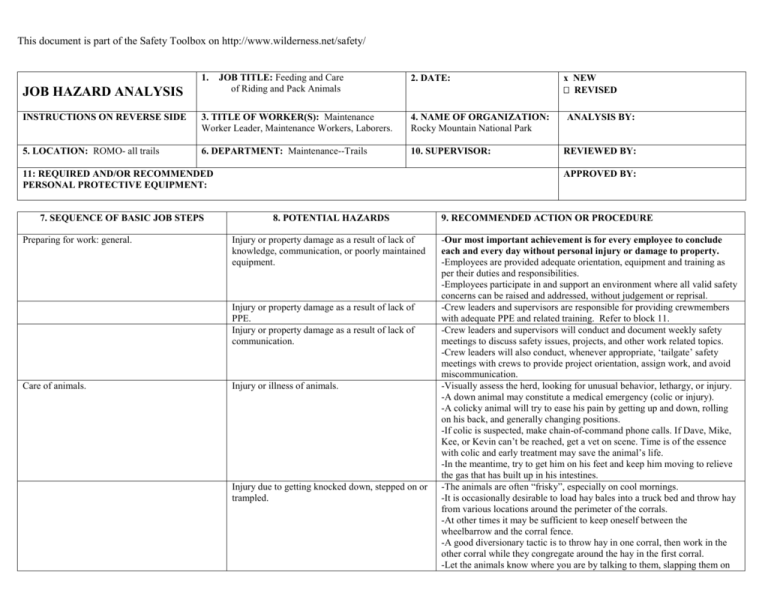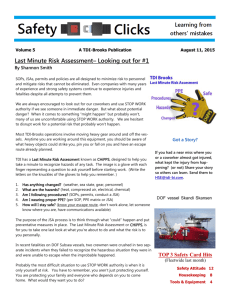Feeding and Care of Animals
advertisement

This document is part of the Safety Toolbox on http://www.wilderness.net/safety/ 1. JOB HAZARD ANALYSIS JOB TITLE: Feeding and Care of Riding and Pack Animals 2. DATE: INSTRUCTIONS ON REVERSE SIDE 3. TITLE OF WORKER(S): Maintenance Worker Leader, Maintenance Workers, Laborers. 4. NAME OF ORGANIZATION: Rocky Mountain National Park 5. LOCATION: ROMO- all trails 6. DEPARTMENT: Maintenance--Trails 10. SUPERVISOR: 11: REQUIRED AND/OR RECOMMENDED PERSONAL PROTECTIVE EQUIPMENT: 7. SEQUENCE OF BASIC JOB STEPS Preparing for work: general. ANALYSIS BY: REVIEWED BY: APPROVED BY: 8. POTENTIAL HAZARDS Injury or property damage as a result of lack of knowledge, communication, or poorly maintained equipment. Injury or property damage as a result of lack of PPE. Injury or property damage as a result of lack of communication. Care of animals. x NEW REVISED Injury or illness of animals. Injury due to getting knocked down, stepped on or trampled. 9. RECOMMENDED ACTION OR PROCEDURE -Our most important achievement is for every employee to conclude each and every day without personal injury or damage to property. -Employees are provided adequate orientation, equipment and training as per their duties and responsibilities. -Employees participate in and support an environment where all valid safety concerns can be raised and addressed, without judgement or reprisal. -Crew leaders and supervisors are responsible for providing crewmembers with adequate PPE and related training. Refer to block 11. -Crew leaders and supervisors will conduct and document weekly safety meetings to discuss safety issues, projects, and other work related topics. -Crew leaders will also conduct, whenever appropriate, ‘tailgate’ safety meetings with crews to provide project orientation, assign work, and avoid miscommunication. -Visually assess the herd, looking for unusual behavior, lethargy, or injury. -A down animal may constitute a medical emergency (colic or injury). -A colicky animal will try to ease his pain by getting up and down, rolling on his back, and generally changing positions. -If colic is suspected, make chain-of-command phone calls. If Dave, Mike, Kee, or Kevin can’t be reached, get a vet on scene. Time is of the essence with colic and early treatment may save the animal’s life. -In the meantime, try to get him on his feet and keep him moving to relieve the gas that has built up in his intestines. -The animals are often “frisky”, especially on cool mornings. -It is occasionally desirable to load hay bales into a truck bed and throw hay from various locations around the perimeter of the corrals. -At other times it may be sufficient to keep oneself between the wheelbarrow and the corral fence. -A good diversionary tactic is to throw hay in one corral, then work in the other corral while they congregate around the hay in the first corral. -Let the animals know where you are by talking to them, slapping them on Injury from lifting and throwing hay bales. Injury to others. their butts etc. -Keep a radio with you in case of an emergency. -Wear steel-toed boots or strap-on foot protection. -Use good body mechanics and techniques when lifting, bending, and pulling. -Always yell something (“Look out below”) before dropping hay bales from the loft. JSA Instructions Emergency Evacuation Instructions The JSA shall identify the location of the work project or activity, the name of employee(s) writing the JSA, the date(s) of development, and the name of the appropriate line officer approving it. The supervisor acknowledges that employees have read and understand the contents, have received the required training, and are qualified to perform the work project or activity. Work supervisors and crew members are responsible for developing and discussing field emergency evacuation procedures (EEP) and alternatives in the event a person(s) becomes seriously ill or injured at the work site. Blocks 1, 2, 3, 4, 5, and 6: Self-explanatory Block 7: Identify all tasks and procedures associated with the work project or activity that have potential to cause injury or illness to personnel and damage to property or material. Include emergency evacuation procedures (EEP). Block 8: Identify all known or suspect hazards associated with each respective task/procedure listed in block 7. For example: a. Research past accidents/incidents. b. Research the Health and Safety Code or other appropriate literature. c. Discuss the work project/activity with participants d. Observe the work project/activity e. A combination of the above Block 9: Identify appropriate actions to reduce or eliminate the hazards identified in block 8. Abatement measures listed below are in the order of the preferred abatement method: a. Engineering Controls (the most desirable method of abatement). For example, ergonomically designed tools, equipment and furniture. b. Substitution. For example, switching to high flash point, non-toxic solvents. c. Administrative Controls. For example, limiting exposure by reducing the work schedule. d. PPE (least desirable method of abatement). For example, using hearing protection when working with or close to portable machines (chain saws, rock drills, portable water pumps) e. A combination of the above. Block 10: The JSA must be reviewed and approved by a supervisor. Block 11: List all recommended and required PPE relevant for job/activity. Be prepared to provide the following information: a. Nature of the accident or injury (avoid using victim’s name). b. Type of assistance needed, if any (ground, air or water evacuation). c. Location of accident or injury, best access route into the work site (road name/number), identifiable ground/air landmarks. d. Radio frequency(s). e. Contact person. f. Local hazards to ground vehicles or aviation. g. Weather conditions (wind speed & direction, visibility, temp). h. Topography. i. Number of person(s) to be transported j. Estimated weight of passengers for air/water evacuation. The items listed above serve only as guidelines for the development of emergency evacuation procedures. JSA and Emergency Evacuation Procedures Acknowledgement As supervisor I acknowledge that the following employees have participated in the development of this JSA, accompanying evacuation procedures and have also been briefed on the provisions thereof: Supervisor’s Signature:





